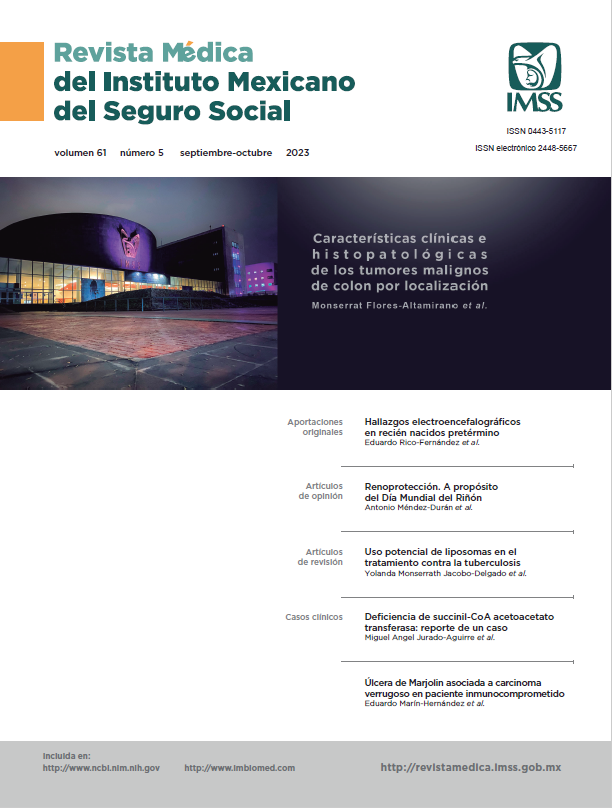Hallazgos electroencefalográficos en recién nacidos pretérmino
##plugins.themes.themeEleven.article.main##
Palabras clave
Recién Nacido, Recién Nacido Prematuro, Electroencefalografía, Factor de Riesgo
Resumen
Introducción: el electroencefalograma (EEG) en el periodo neonatal es muy superior al examen clínico en la detección y pronóstico de disfunciones cerebrales, pues permite hacer una documentación funcional cerebral continua y no invasiva junto a la cama del paciente. Sin embargo, todavía hay cierto desacuerdo sobre estos hallazgos.
Objetivo: describir los hallazgos electroencefalográficos en recién nacidos (RN) con antecedente de prematurez.
Material y métodos: estudio transversal, descriptivo, retrospectivo. Los criterios de inclusión fueron: RN con antecedente de prematurez, sin distinción de género, a quienes se les haya hecho un EEG de junio de 2017 a junio de 2021. Se excluyeron pacientes con registro electroencefalográfico incompleto o expediente clínico sin datos completos; se eliminaron del estudio pacientes que usaran sedantes (tiopental, fentanilo, midazolam, diazepam).
Resultados: se incluyeron 107 pacientes (37 mujeres y 70 hombres) con antecedente de prematurez, con una edad gestacional media al nacer de 30.9 SDG ± 3.25. Los hallazgos de EEG fueron normales en 40%, anormales en 32% e inmaduros en 28%. El hallazgo anormal más frecuente fue la actividad paroxística focal en 86%. El 93.4% de los participantes presentaban comorbilidades, sobre todo neurológicas.
Conclusión: los RN pretérmino tienen un alto riesgo de secuelas neurológicas y el EEG es un método sensible para evaluar el pronóstico neuromotor y cognitivo. En nuestra población un tercio tuvo hallazgos anormales. El rastreo posnatal temprano es útil, pero se necesitan registros adicionales para detectar RN de alto riesgo. Es importante continuar esta línea de investigación en pediatría.
Referencias
World Health Organization. International Statistical Classification of Diseases and related health problems: Volume 3 alphabetical index. 10th ed. Geneva: WHO; 2004. 677 pp.
Jiménez-Acosta YC, Gómez-Garnica MF, Contreras-Peregrina MR, et al. Perfil epidemiológico del recién nacido pretérmino en una institución privada del Occidente de México. Rev Med MD. 2016;7.8(4):270-4.
Padilla-Muñoz H, Gutiérrez-Padilla JA, González-Sánchez R, et al. Perfil de morbilidad y mortalidad de la UCINEX del Hospital Civil de Guadalajara Fray Antonio Alcalde del 2005 al 2012. Rev Med MD. 2014;5.6(4):182-8.
García-Hernández HA, Valle-Delgado E, Angulo-Castellanos E, et al. Morbilidad y mortalidad de un Centro Regional en Atención Neonatal del Occidente de México (2012- 2015). Rev Med MD. 2016;7.8(4):247-53.
Cupen K, Barran A, Singh V, et al. Risk Factors Associated with Preterm Neonatal Mortality: A Case Study Using Data from Mt. Hope Women's Hospital in Trinidad and Tobago. Children (Basel). 2017;4(12):108. doi: 10.3390/children4120108
Howson CP, Kinney MV, McDougall L, et al. Born Too Soon Preterm Birth Action Group. Born too soon: preterm birth matters. Reprod Health. 2013;10(Suppl 1):S1. doi: 10.1186/1742-4755-10-S1-S1.
Secretaría de Salud. Norma Oficial Mexicana NOM 007-SSA2-2016, Para la atención de la mujer en el embarazo, parto y puerperio, y de la persona recién nacida. México: Secretaría de Salud; 2016. Disponible en: https://www.dof.gob.mx/nota_detalle.php?codigo=5432289&fecha=07/04/2016#gsc.tab=0.
Mosley WH, Chen LC. An analytical framework for the study of child survival in developing countries. 1984. Bull World Health Organ. 2003;81(2):140-5.
Blencowe H, Cousens S, Chou D, et al. Born Too Soon Preterm Birth Action Group. Born too soon: the global epidemiology of 15 million preterm births. Reprod Health. 2013;10 (Suppl 1):1-14. doi: 10.1186/1742-4755-10-S1-S2.
Glass HC, Costarino AT, Stayer SA, et al. Outcomes for extremely premature infants. Anesth Analg. 2015;120(6):1337-51. doi: 10.1213/ANE.0000000000000705.
Kobaly K, Schluchter M, Minich N, et al. Outcomes of extremely low birth weight (<1 kg) and extremely low gestational age (<28 weeks) infants with bronchopulmonary dysplasia: effects of practice changes in 2000 to 2003. Pediatrics. 2008;121(1):73-81. doi: 10.1542/peds.2007-1444.
Dreyfus-Brisac C. Neonatal electroencephalography. In: Scarpelli EM, Cosmi EV, editors. Perinatal Medicine. New York: Raven Press; 1979. pp. 397-472.
Verma UL, Archbald F, Tejani NA, et al. Cerebral function monitor in the neonate. I: Normal patterns. Dev Med Child Neurol. 1984;26(2):154-61. doi: 10.1111/j.1469-8749
Hellström-Westas L, Rosén I, Svenningsen NW. Cerebral function monitoring during the first week of life in extremely small low birthweight (ESLBW) infants. Neuropediatrics. 1991;22(1):27-32. doi: 10.1055/s-2008-1071411.
Burdjalov VF, Baumgart S, Spitzer AR. Cerebral function monitoring: a new scoring system for the evaluation of brain maturation in neonates. Pediatrics. 2003;112(4):855-61. doi: 10.1542/peds.112.4.855.
Frenkel N, Friger M, Meledin I, et al. Neonatal seizure recognition--comparative study of continuous-amplitude integrated EEG versus short conventional EEG recordings. Clin Neurophysiol. 2011;122(6):1091-7. doi: 10.1016/j.clinph.2010.09.028.
Soubasi V, Mitsakis K, Sarafidis K, et al. Early abnormal amplitude-integrated electroencephalography (aEEG) is associated with adverse short-term outcome in premature infants. Eur J Paediatr Neurol. 2012;16(6):625-30. doi: 10.1016/j.ejpn.2012.02.008.
Schmidt-Mellado G, Pillay K, Adams E, et al. The impact of premature extrauterine exposure on infants' stimulus-evoked brain activity across multiple sensory systems. Neuroimage Clin. 2022;33:1-15. doi: 10.1016/j.nicl.2021.102914.
Pineda RG, Neil J, Dierker D, et al. Alterations in brain structure and neurodevelopmental outcome in preterm infants hospitalized in different neonatal intensive care unit environments. J Pediatr. 2014;164(1):1-22. doi: 10.1016/j.jpeds.2013.08.047.
Wallois, F, Routier, L, Bourel Ponchel, E. Chapter 25: Impact of prematurity on neurodevelopment. in: Handbook of Clinical Neurology. Gallagher A, Bulteau C, Cohen D, editors. Amsterdam: Elsevier; 2020. pp. 341-75.
Adams JN, Feldman HM, Huffman LC, et al. Sensory processing in preterm preschoolers and its association with executive function. Early Hum Dev. 2015;91(3):227-33. doi: 10.1016/j.earlhumdev.2015.01.013.
Mwaniki MK, Atieno M, Lawn JE, et al. Long-term neurodevelopmental outcomes after intrauterine and neonatal insults: a systematic review. Lancet. 2012;379(9814):445-52. doi: 10.1016/S0140-6736(11)61577-8.
Mizrahi EM, Hrachovy RA. Atlas of Neonatal Electroencephalography. 4a ed. Nueva York: Demos Medical Publishing; 2015.
Fogtmann EP, Plomgaard AM, Greisen G, et al. Prognostic Accuracy of Electroencephalograms in Preterm Infants: A Systematic Review. Pediatrics. 2017;139(2):1-16. doi: 10.1542/peds.2016-1951.
Le Bihannic A, Beauvais K, Busnel A, et al. Prognostic value of EEG in very premature newborns. Arch Dis Child Fetal Neonatal Ed. 2012;97(2):1-5. doi: 10.1136/adc.2010.204735.
Selton D, Andre M, Debruille C, et al. Cognitive outcome at 5 years in very premature children without severe early cerebral abnormalities. Relationships with EEG at 6 weeks after birth. Neurophysiol Clin. 2013;43(5-6):289-97. doi: 10.1016/j.neucli.2013.09.003.
Selton D, André M, Debruille C, et al. EEG at 6 weeks of life in very premature neonates. Clin Neurophysiol. 2010;121(6):818-22. doi: 10.1016/j.clinph.2009.11.006.


